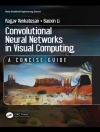AUTONOMOUS AIRBORNE WIRELESS NETWORKS
Discover what lies beyond the bleeding-edge of autonomous airborne networks with this authoritative new resource
Autonomous Airborne Wireless Networks delivers an insightful exploration on recent advances in the theory and practice of using airborne wireless networks to provide emergency communications, coverage and capacity expansion, information dissemination, and more. The distinguished engineers and editors have selected resources that cover the fundamentals of airborne networks, including channel models, recent regulation developments, self-organized networking, AI-enabled flying networks, and notable applications in a variety of industries.
The book evaluates advances in the cutting-edge of unmanned aerial vehicle wireless network technology while offering readers new ideas on how airborne wireless networks can support various applications expected of future networks. The rapidly developing field is examined from a fresh perspective, one not just concerned with ideas of control, trajectory optimization, and navigation.
Autonomous Airborne Wireless Networks considers several potential use cases for the technology and demonstrates how it can be integrated with concepts from self-organized network technology and artificial intelligence to deliver results in those cases. Readers will also enjoy:
* A thorough discussion of distributed drone base station positioning for emergency cellular networks using reinforcement learning (AI-enabled trajectory optimization)
* An exploration of unmanned aerial vehicle-to-wearables (UAV2W) indoor radio propagation channel measurements and modelling
* An up-to-date treatment of energy minimization in UAV trajectory design for delay tolerant emergency communication
* Examinations of cache-enabled UAVs, 3D MIMO for airborne networks, and airborne networks for Internet of Things communications
Perfect for telecom engineers and industry professionals working on identifying practical and efficient concepts tailored to overcome challenges facing unmanned aerial vehicles providing wireless communications, Autonomous Airborne Wireless Networks also has a place on the bookshelves of stakeholders, regulators, and research agencies working on the latest developments in UAV communications.
Tabella dei contenuti
Editor biography
Contributors list
Chapter 1 Introduction
Muhammad A Imran, Oluwakayode Onireti, Shuja S Ansari, Qammer H Abbasi
Chapter 2 Channel Model for Airborne Networks
Aziz Altaf Khuwaja and Yunfei Chen
Chapter 3 Ultra-Wide Band Channel Measurements and Modelling for Unmanned Aerial Vehicle-to-Wearables (UAV2W) Systems
Amit Kachroo, Surbhi Vishwakarma, Jacob N. Dixon, Hisham Abuella, Adithya Popuri, Qammer H. Abbasi, Charles F. Bunting,
Jamey D. Jacob, Sabit Ekin,
Chapter 4 A cooperative multi-agent approach for optimal drone deployment using reinforcement learning
Rigoberto Acosta-González, Paulo Valente Klaine, Samuel Montejo-Sánchez, Richard Demo, Lei Zhang, Muhammad A. Imran
Chapter 5 SWIPT-PS Enabled Cache-Aided Self-Energized UAV for Cooperative Communication
Tharindu D. Ponnimbaduge Perera
Chapter 6 Performance of mm Wave UAV-Assisted 5G Hybrid Heterogeneous Networks
Muhammad Karam Shehzad, Muhammad Waseem Akhtar, Syed Ali Hassan
Chapter 7 UAV-Enabled Cooperative Jamming for Physical Layer Security in Cognitive Radio Network
Phu Xuan Nguyen, Hieu Van Nguyen, Van-Dinh Nguyen, Oh-Soon Shin
Chapter 8 IRS assisted Localization for Airborne Mobile Networks
Olaoluwa Popoola, Shuja Ansari, Rafay Iqbal Ansari, Lina Mohjazi, Syed Ali Hassan,
Nauman Aslam, Qammer Hussain Abbasi, Muhammad Ali Imran
Chapter 9 Performance Analysis of UAV Enabled Disaster Recovery Networks
Rabeea Basir, Naveed Ahmad Chughtai, Saad Qaisar, Mudassar Ali, Muhammad Ali Imran
Chapter 10 Network-assisted Unmanned Aerial Vehicle Communication for Smart Monitoring of Lock-down
Navuday Sharma, Muhammad Awais, Haris Pervaiz, Hassan Malik, Qiang Ni
Chapter 11 Unmanned Aerial Vehicles for Agriculture: an overview of Io T-based scenarios
Bacco Manlio, Barsocchi Paolo, Gotta Alberto, Ruggeri Massimiliano
Chapter 12 Airborne Systems and Underwater Monitoring
Elizabeth Basha, Jason To-Tran, Davis Young, Sean Thalken, Christopher Uramoto
Chapter 13 Demystifying Futuristic Satellite Networks: Requirements, Security Threats, and Issues
Muhammad Usman, Muhammad Rizwan Asghar, Imran Shafique Ansari, Marwa Qaraqe
Chapter 14 Conclusions and future outlook
Muhammad Imran, Oluwakayode, Shuja Ansari and Qammer Abbasi
Circa l’autore
Muhammad Ali Imran, is Dean University of Glasgow, UESTC, Professor of Communication Systems and Head of Communications Sensing and Imaging Group at the James Watt School of Engineering, University of Glasgow, UK.
Oluwakayode Onireti, Ph D, is a Lecturer at the James Watt School of Engineering, University of Glasgow, UK. He received his Ph D in Electronics Engineering from the University of Surrey in Guildford, UK.
Shuja Ansari, Ph D, is currently a Research Associate at University of Glasgow and actively involved as a Use Case implementation lead for Wave-1 Urban Innovation Projects for Scotland 5G Centre. He received his Ph D in Engineering from Glasgow Caledonian University, UK.
Qammer H. Abbasi, is Senior Lecturer (Associate Professor) and Deputy Head of Communications Sensing and Imaging Group at the James Watt School of Engineering the University of Glasgow, UK.












